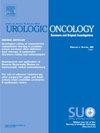Contemporary outcomes for robotic radical cystectomy and intracorporeal neobladder urinary diversion
IF 2.4
3区 医学
Q3 ONCOLOGY
Urologic Oncology-seminars and Original Investigations
Pub Date : 2025-03-06
DOI:10.1016/j.urolonc.2025.02.006
引用次数: 0
Abstract
Introduction
Widespread adoption of robotic-assisted radical cystectomy (RARC) with totally intracorporeal neobladder urinary diversion (UD) has not been achieved, and there is a dearth of literature exploring its short-term and long-term safety. We aim to present perioperative, complications, and oncologic outcomes for this procedure.
Materials and Methods
Data from patients who underwent RARC with intracorporeal neobladder UD for bladder cancer between 2003 and 2022 from our multi-institutional cohort was prospectively collected. A retrospective review of this data was performed. The primary outcome was the number of days the patient was alive and outside of the hospital within 90 days postoperatively. Secondary outcomes were recurrence-free survival (RFS), cancer-specific survival (CSS), and overall survival (OS) at 24-months estimated by Kaplan-Meier plots, and 30-day and 90-day overall and major (Clavien ≥III) complication rates.
Results
Of 410 patients (370 [90%] male), median (IQR) age was 64.2 (58.0, 69.4) and BMI was 26.8 (23.9, 29.1) kg/m2. The cohort included 2 (0.5%) cT0, 46 (11%) cTa or cTis, 109 (7%) cT1, 202 (49%) cT2, 47 (11%) cT3, and 4 (1.0%) cT4 tumors preoperatively. Median (IQR) follow-up was 37.6 (11.1, 81.0) months. Surgical margins were positive in 8 (2.0%) patients. Median number of days alive and outside hospital within 90 days postoperatively was 82 (77,85). Clavien III-IV complications occurred in 63 (15%) and 88 (21%) patients within 30 and 90 days, respectively. Clavien V complications occurred in 1 (0.2%) and 2 (0.5%) patients within 30 and 90 days, respectively. Kaplan-Meier estimates for RFS, CSS, and OS at 24-months were 78%, 88%, and 86%, respectively.
Discussion
RARC with intracorporeal neobladder UD led to favorable recovery with increased days alive and out of the hospital within 90-days of surgery compared to open RC series, and major complication rates and oncologic outcomes were in line with prior open RC series.
机器人根治性膀胱切除术和体外新膀胱内尿转移的当代疗效。
导论:机器人辅助根治性膀胱切除术(RARC)联合全体内新膀胱尿转移术(UD)尚未被广泛采用,且缺乏研究其短期和长期安全性的文献。我们的目的是介绍围手术期、并发症和肿瘤预后。材料和方法:前瞻性地收集了2003年至2022年间膀胱癌患者接受RARC合并体内新膀胱UD的数据。对这些数据进行回顾性审查。主要观察指标是术后90天内患者存活和出院的天数。次要结局是Kaplan-Meier图估计的24个月无复发生存期(RFS)、癌症特异性生存期(CSS)和总生存期(OS),以及30天和90天的总并发症和主要(Clavien≥III)并发症发生率。结果:410例患者(370例[90%]男性)中位(IQR)年龄为64.2 (58.0,69.4),BMI为26.8 (23.9,29.1)kg/m2。该队列包括术前2例(0.5%)cT0, 46例(11%)cTa或cTis, 109例(7%)cT1, 202例(49%)cT2, 47例(11%)cT3和4例(1.0%)cT4肿瘤。中位(IQR)随访时间为37.6(11.1,81.0)个月。8例(2.0%)患者手术切缘阳性。术后90天内存活和出院天数中位数为82天(77,85)。Clavien III-IV期并发症在30天和90天内分别发生63例(15%)和88例(21%)。Clavien V在30天和90天内分别出现1例(0.2%)和2例(0.5%)并发症。Kaplan-Meier估计,24个月时的RFS、CSS和OS分别为78%、88%和86%。讨论:与开放式RC系列相比,RARC合并体内新膀胱UD的患者在手术后90天内存活和出院天数增加,恢复良好,主要并发症发生率和肿瘤预后与先前的开放式RC系列一致。
本文章由计算机程序翻译,如有差异,请以英文原文为准。
求助全文
约1分钟内获得全文
求助全文
来源期刊
CiteScore
4.80
自引率
3.70%
发文量
297
审稿时长
7.6 weeks
期刊介绍:
Urologic Oncology: Seminars and Original Investigations is the official journal of the Society of Urologic Oncology. The journal publishes practical, timely, and relevant clinical and basic science research articles which address any aspect of urologic oncology. Each issue comprises original research, news and topics, survey articles providing short commentaries on other important articles in the urologic oncology literature, and reviews including an in-depth Seminar examining a specific clinical dilemma. The journal periodically publishes supplement issues devoted to areas of current interest to the urologic oncology community. Articles published are of interest to researchers and the clinicians involved in the practice of urologic oncology including urologists, oncologists, and radiologists.

 求助内容:
求助内容: 应助结果提醒方式:
应助结果提醒方式:


